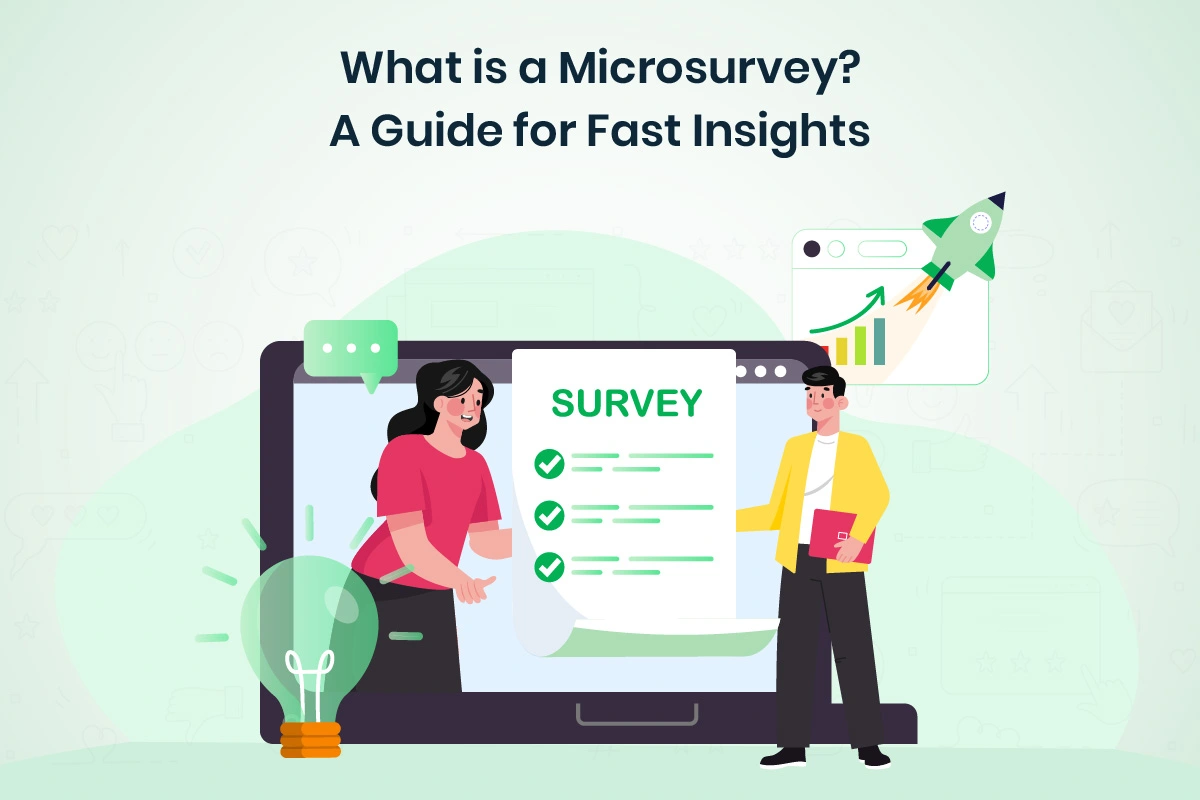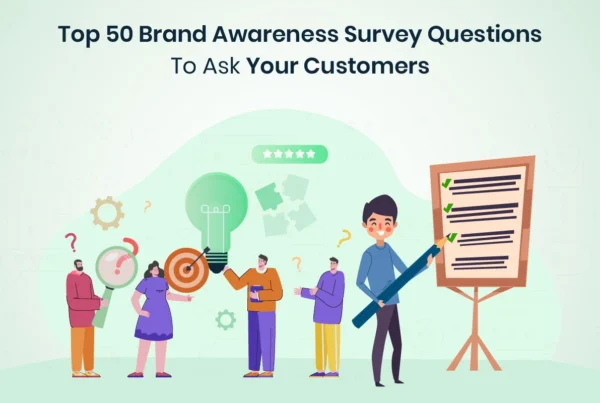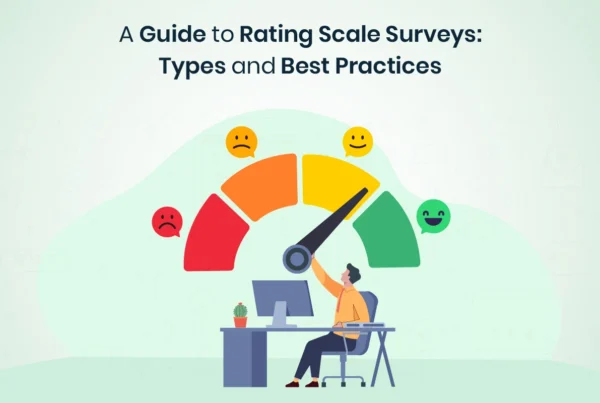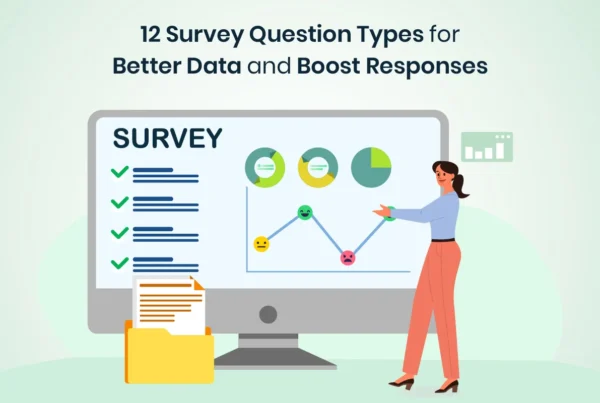Traditional surveys are lengthy, leading to survey fatigue among individuals. Enter Microsurveys which are short and focused surveys designed to gather quick responses from customers. It is essential to address the core question – what is a microsurvey and what are its consequences? This blog will be a complete guide to a micro survey.
What is a Microsurvey?
A micro survey is an easy way to collect contextual user feedback, and its purpose is not to overwhelm respondents but just collect data sufficient to make actionable improvements. A micro survey is an in-app and website survey that usually contains just one to three questions. These bite-sized surveys ensure higher completion rates and overall, a better response from users.
Micro surveys are used at a high moment in the customer journey to obtain authentic in-the-moment feedback without triggering a change in the user experience.
Traditional Surveys vs Microsurvey
Both micro surveys and traditional surveys serve the purpose of collecting feedback, but their methodologies differ significantly. Traditional surveys are comprehensive and often used for in-depth research, while micro surveys are more agile. The former may contain 20 or more questions covering various aspects of the user experience, and a micro survey typically focuses on one subject area.
Moreover, traditional surveys are mostly scheduled while micro surveys may be seamlessly incorporated into customer journeys, for example, after a purchase of confirmation or app interaction. Such flexibility allows businesses to adjust their strategies at a much quicker pace as per the changing demands of the customers. Traditional surveys are usually not capable of doing because of their lengthy and time-consuming analysis process.
Advantages of Implementation
Many businesses in all industries are adopting micro surveys in customer experience initiatives because of their charm of being accurate and efficient. Micro survey enables brands to capture feedback along different touchpoints along the customer journey such that it is easy to monitor trends as they develop.
This approach also helps companies reduce the chances of recall bias, leading to a clearer picture of customer feelings. By collecting data in smaller segments, businesses can quickly analyze the data and make necessary adjustments on the go. Enterprises can identify challenges and make proactive improvements before they escalate.
Micro surveys also increase personalization. Businesses can ask questions based on specific user experiences or preferences to generate better data. The other important benefit of micro surveys is contributing to long-term engagement. When users are aware that their feedback is understood and incorporated, trust and loyalty build. This is something that every business is hoping to achieve.
Micro surveys can add more depth to the insights gained from different feedback tools, such as social listening and analytics dashboards. This combination gives you a fuller experience of user sentiment, as well as understanding their motivations behind that sentiment when partnering with behavioral analytics.
Types of Micro Surveys
Micro surveys can take on various formats based on the objective of gathering feedback. Some of the most common ones are:
1. Customer Satisfaction (CSAT) Surveys: Used to assess immediate satisfaction after certain interactions, such as support tickets or buying things.
2. Net Promoter Score (NPS): A single-question format that asks users how likely they are to recommend a product or service.
3. Customer Effort Score (CES): Focuses on how easy or hard it was for customers to accomplish a task.
Each type has a different role and shares a common concept called accuracy.
Benefits
One of the benefits of micro surveys is its design. Being short, micro surveys do not get in the way of users trying to accomplish the task at hand, such as using an application. This means respondents are allowed to respond to feedback requests in a respectful manner, and generally leads to more introspective, authentic responses.
Another benefit is improved data quality. When respondents don’t have to put much effort into their responses, they are less likely to rush through the survey. Therefore, better quality responses can be anticipated. Real-time trending is possible, and this gives companies an opportunity to track shifts in sentiment and act ahead of the shift.
Implementing Micro surveys in CX Strategy
The quality of a micro survey largely depends on how well it is executed. To start with, businesses must establish clear goals and figure out the exact data or insight that they want to get. If the case is that they need to improve onboarding, change a feature, or elevate a service touchpoint, it is absolutely necessary to be clear about what they intend to measure.
Second, embedding the micro surveys in the right channels, web, mobile, email, or a chat bot or interface, gives more visibility and likelihood for a response. Timing matters and asking a micro survey just after a key interaction tends to disclose the most genuine responses.
Finally, leverage the feedback loop. Following up with respondents based on what they indicated in the micro survey establishes trust, demonstrates consideration for their opinions, and encourages future responses.
Modern Survey Software
The role of technology is essential to enabling micro survey execution. Survey software platforms today have greatly enhanced capabilities to easily create, send, and analyze micro surveys. Customizable templates, automation workflows, and analytics dashboards can be used to create actionable insights.
Customer experience tools like piHappiness enable businesses to create interactive micro surveys around user experience. piHappiness can integrate with CRM tools in a way that feedback data from the micro survey always forms part of larger business intelligence data. Making use of survey platforms can facilitate automated feedback, reduce manual work, and enhance data accuracy.
Challenges with Micro Survey
A commonly discussed challenge with micro surveys is its overuse. If users see surveys too many times, they may burn out. This can be resolved by balancing survey frequency and relevance. Segment target audiences and strategically rotate questions periodically.
A second challenge involves demonstrating data reliability. Given that micro surveys provide a limited and few responses, sample bias can occur. To avoid sample bias, businesses should deploy micro surveys to multiple channels over time.
And another challenge is interpretation may be difficult without collection context. To address this concern, micro survey outcomes can be validated with qualitative data or open-ended follow-up.
Conclusion
Micro surveys have become a significant evolution of feedback management, to which they fit perfectly in a fast-moving and customer-centric market as they provide very quickly manageable insights. By knowing precisely what is a micro survey, using it strategically, and employing the latest survey tools like piHappiness, businesses can implement quicker decision-making
Since enterprises are heavily investing in personalization, the importance of micro surveys has risen significantly as a link between data analysis and taking real actions. Micro surveys restart the feedback process and, thus, lead to building strong bonds that are the basis of success in the current business world.
Book a quick demo today. See how piHappiness works.








